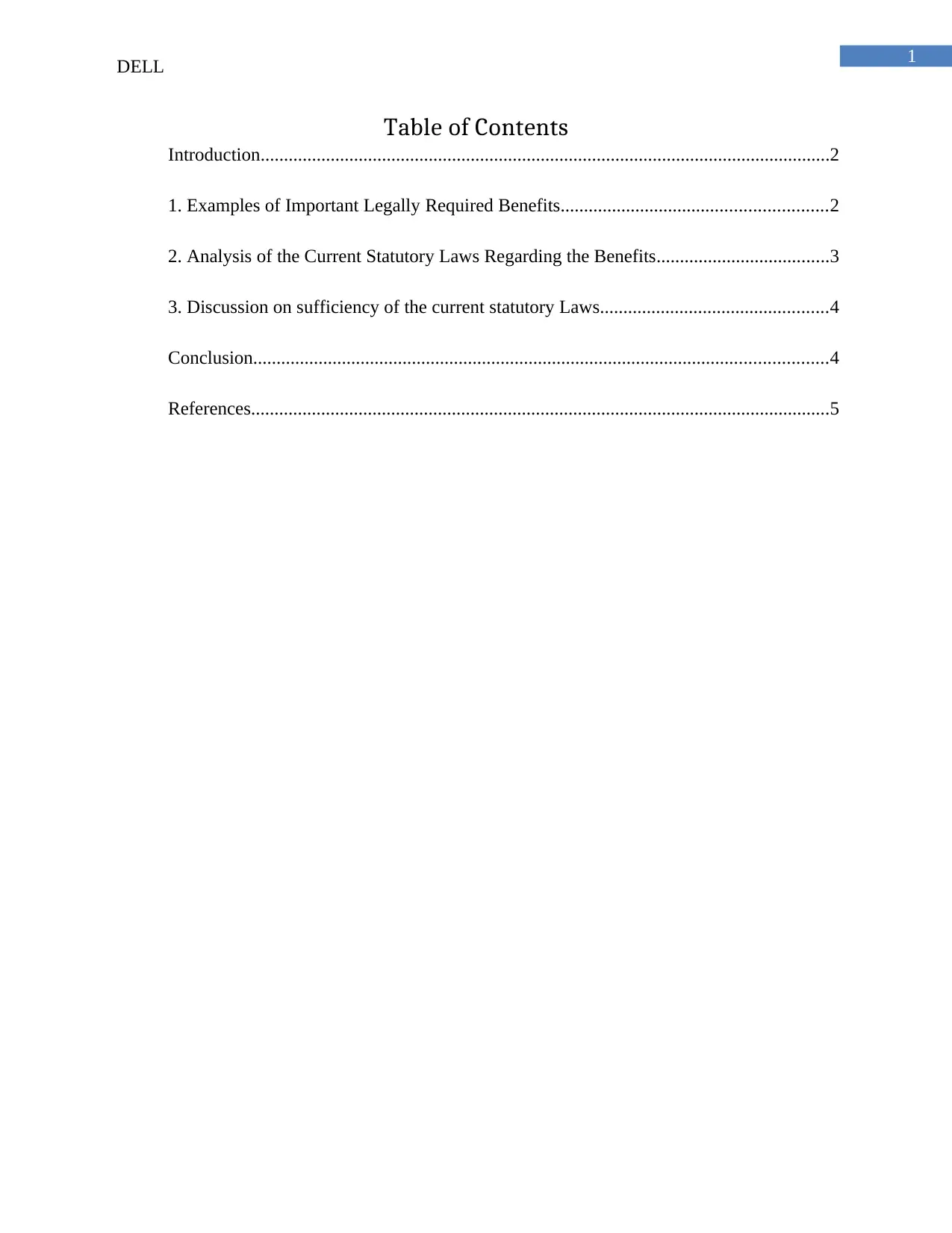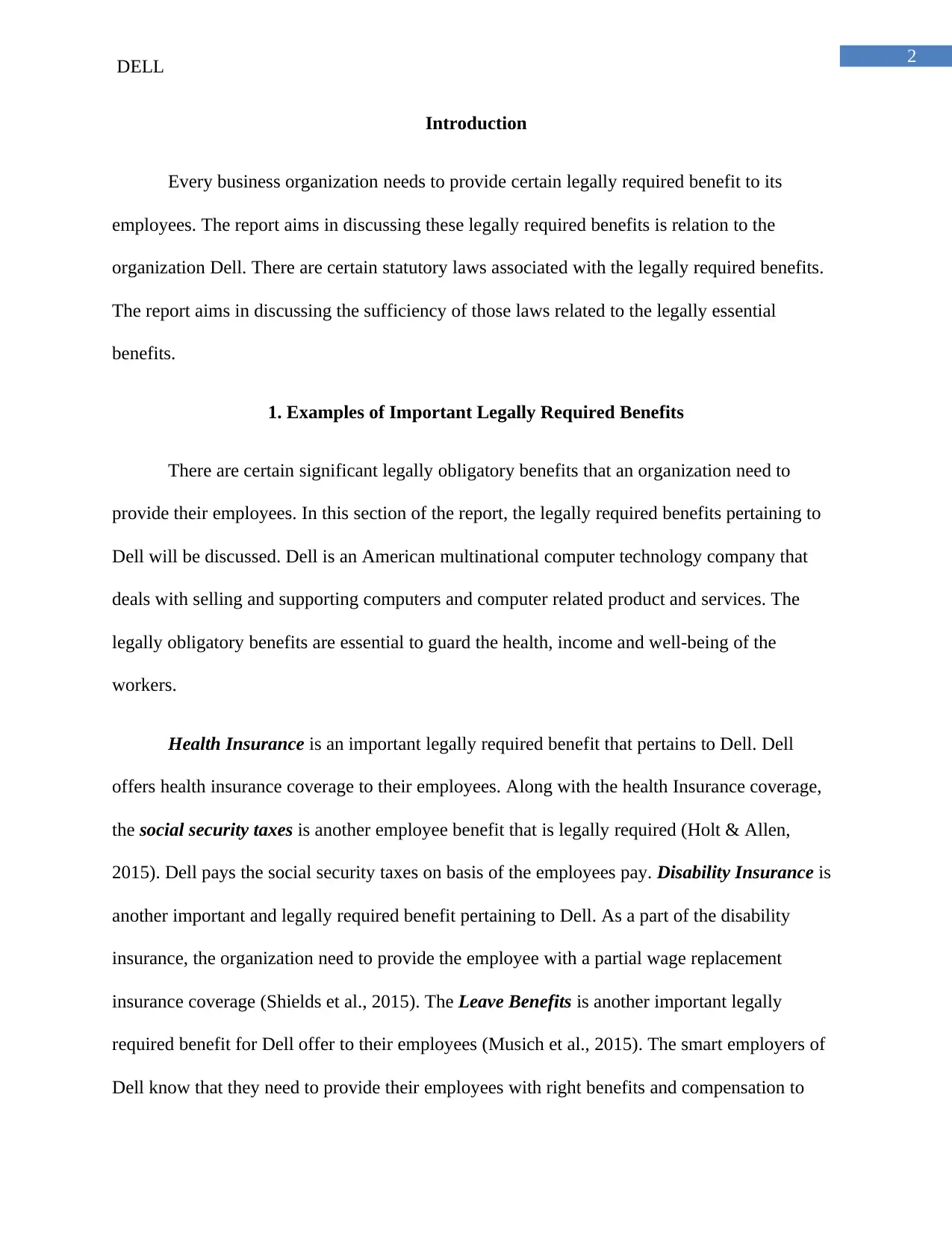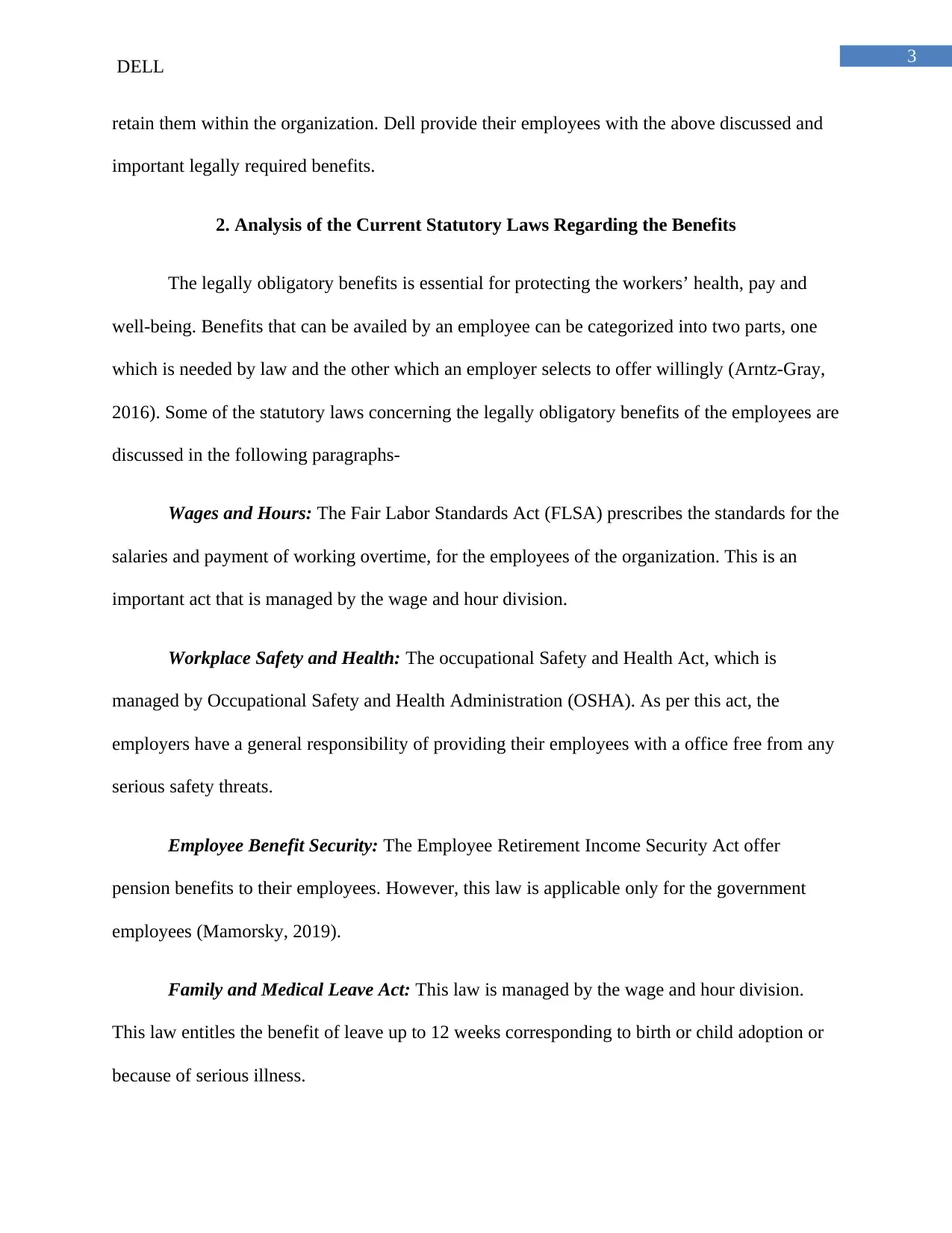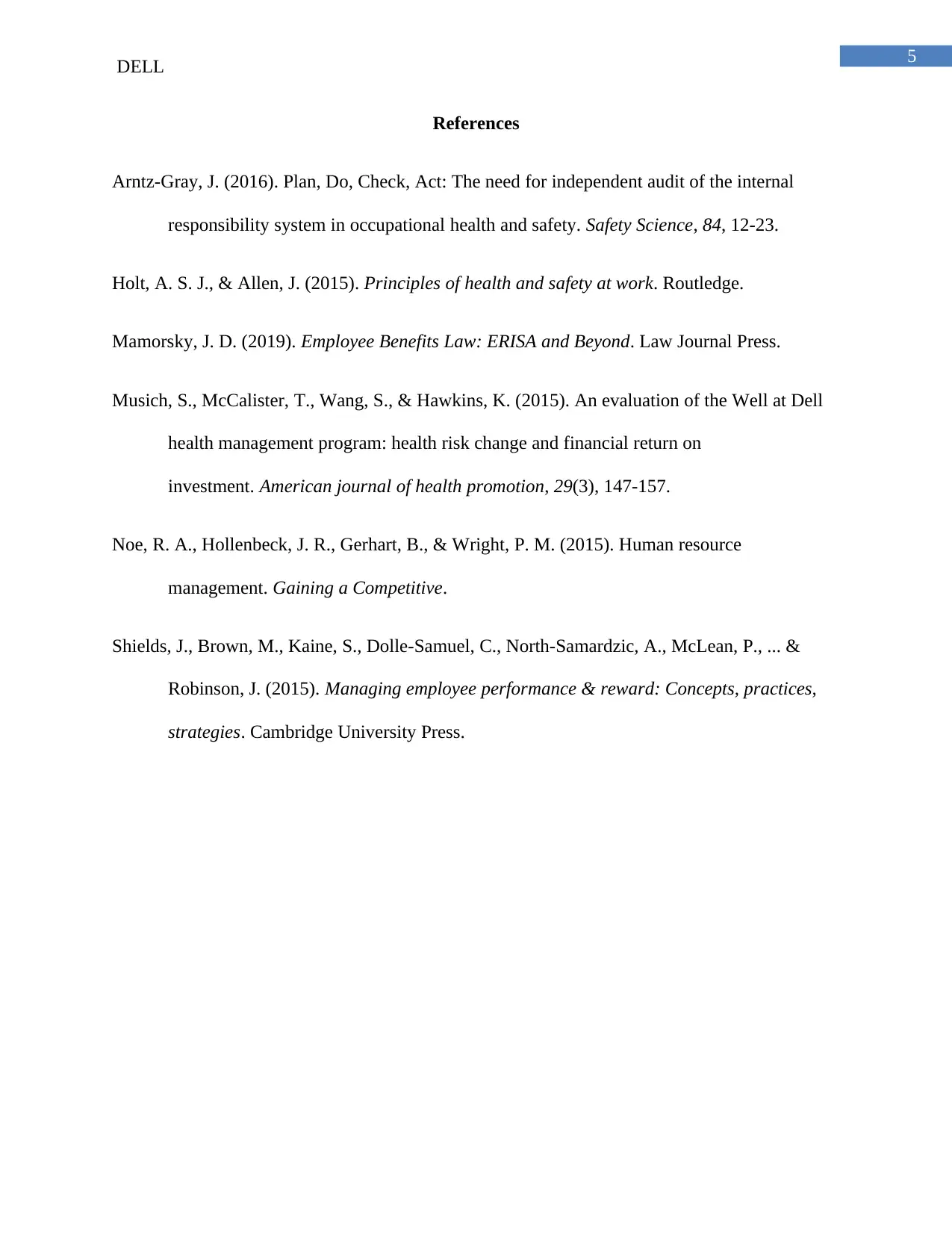HR435: Legally Required Benefits Analysis for Dell
VerifiedAdded on 2022/08/12
|6
|1127
|20
Report
AI Summary
This report provides an overview of the legally required benefits that Dell provides to its employees. It identifies key benefits such as health insurance, social security taxes, disability insurance, and leave benefits, emphasizing their importance in safeguarding employee well-being. The report then analyzes the current statutory laws, including the Fair Labor Standards Act (FLSA), Occupational Safety and Health Act (OSHA), Employee Retirement Income Security Act (ERISA), and Family and Medical Leave Act, that govern these benefits. It concludes that while the existing laws offer a degree of protection, the number of laws are sufficient considering the challenges employees face in the workplace, particularly in the context of the US Department of Labor's extensive regulatory framework covering millions of employers.

Running head: DELL
Dell - Legally Required Benefits
Name of Student
Name of University
Author Note
Dell - Legally Required Benefits
Name of Student
Name of University
Author Note
Paraphrase This Document
Need a fresh take? Get an instant paraphrase of this document with our AI Paraphraser

1
DELL
Table of Contents
Introduction..........................................................................................................................2
1. Examples of Important Legally Required Benefits.........................................................2
2. Analysis of the Current Statutory Laws Regarding the Benefits.....................................3
3. Discussion on sufficiency of the current statutory Laws.................................................4
Conclusion...........................................................................................................................4
References............................................................................................................................5
DELL
Table of Contents
Introduction..........................................................................................................................2
1. Examples of Important Legally Required Benefits.........................................................2
2. Analysis of the Current Statutory Laws Regarding the Benefits.....................................3
3. Discussion on sufficiency of the current statutory Laws.................................................4
Conclusion...........................................................................................................................4
References............................................................................................................................5

2
DELL
Introduction
Every business organization needs to provide certain legally required benefit to its
employees. The report aims in discussing these legally required benefits is relation to the
organization Dell. There are certain statutory laws associated with the legally required benefits.
The report aims in discussing the sufficiency of those laws related to the legally essential
benefits.
1. Examples of Important Legally Required Benefits
There are certain significant legally obligatory benefits that an organization need to
provide their employees. In this section of the report, the legally required benefits pertaining to
Dell will be discussed. Dell is an American multinational computer technology company that
deals with selling and supporting computers and computer related product and services. The
legally obligatory benefits are essential to guard the health, income and well-being of the
workers.
Health Insurance is an important legally required benefit that pertains to Dell. Dell
offers health insurance coverage to their employees. Along with the health Insurance coverage,
the social security taxes is another employee benefit that is legally required (Holt & Allen,
2015). Dell pays the social security taxes on basis of the employees pay. Disability Insurance is
another important and legally required benefit pertaining to Dell. As a part of the disability
insurance, the organization need to provide the employee with a partial wage replacement
insurance coverage (Shields et al., 2015). The Leave Benefits is another important legally
required benefit for Dell offer to their employees (Musich et al., 2015). The smart employers of
Dell know that they need to provide their employees with right benefits and compensation to
DELL
Introduction
Every business organization needs to provide certain legally required benefit to its
employees. The report aims in discussing these legally required benefits is relation to the
organization Dell. There are certain statutory laws associated with the legally required benefits.
The report aims in discussing the sufficiency of those laws related to the legally essential
benefits.
1. Examples of Important Legally Required Benefits
There are certain significant legally obligatory benefits that an organization need to
provide their employees. In this section of the report, the legally required benefits pertaining to
Dell will be discussed. Dell is an American multinational computer technology company that
deals with selling and supporting computers and computer related product and services. The
legally obligatory benefits are essential to guard the health, income and well-being of the
workers.
Health Insurance is an important legally required benefit that pertains to Dell. Dell
offers health insurance coverage to their employees. Along with the health Insurance coverage,
the social security taxes is another employee benefit that is legally required (Holt & Allen,
2015). Dell pays the social security taxes on basis of the employees pay. Disability Insurance is
another important and legally required benefit pertaining to Dell. As a part of the disability
insurance, the organization need to provide the employee with a partial wage replacement
insurance coverage (Shields et al., 2015). The Leave Benefits is another important legally
required benefit for Dell offer to their employees (Musich et al., 2015). The smart employers of
Dell know that they need to provide their employees with right benefits and compensation to
⊘ This is a preview!⊘
Do you want full access?
Subscribe today to unlock all pages.

Trusted by 1+ million students worldwide

3
DELL
retain them within the organization. Dell provide their employees with the above discussed and
important legally required benefits.
2. Analysis of the Current Statutory Laws Regarding the Benefits
The legally obligatory benefits is essential for protecting the workers’ health, pay and
well-being. Benefits that can be availed by an employee can be categorized into two parts, one
which is needed by law and the other which an employer selects to offer willingly (Arntz-Gray,
2016). Some of the statutory laws concerning the legally obligatory benefits of the employees are
discussed in the following paragraphs-
Wages and Hours: The Fair Labor Standards Act (FLSA) prescribes the standards for the
salaries and payment of working overtime, for the employees of the organization. This is an
important act that is managed by the wage and hour division.
Workplace Safety and Health: The occupational Safety and Health Act, which is
managed by Occupational Safety and Health Administration (OSHA). As per this act, the
employers have a general responsibility of providing their employees with a office free from any
serious safety threats.
Employee Benefit Security: The Employee Retirement Income Security Act offer
pension benefits to their employees. However, this law is applicable only for the government
employees (Mamorsky, 2019).
Family and Medical Leave Act: This law is managed by the wage and hour division.
This law entitles the benefit of leave up to 12 weeks corresponding to birth or child adoption or
because of serious illness.
DELL
retain them within the organization. Dell provide their employees with the above discussed and
important legally required benefits.
2. Analysis of the Current Statutory Laws Regarding the Benefits
The legally obligatory benefits is essential for protecting the workers’ health, pay and
well-being. Benefits that can be availed by an employee can be categorized into two parts, one
which is needed by law and the other which an employer selects to offer willingly (Arntz-Gray,
2016). Some of the statutory laws concerning the legally obligatory benefits of the employees are
discussed in the following paragraphs-
Wages and Hours: The Fair Labor Standards Act (FLSA) prescribes the standards for the
salaries and payment of working overtime, for the employees of the organization. This is an
important act that is managed by the wage and hour division.
Workplace Safety and Health: The occupational Safety and Health Act, which is
managed by Occupational Safety and Health Administration (OSHA). As per this act, the
employers have a general responsibility of providing their employees with a office free from any
serious safety threats.
Employee Benefit Security: The Employee Retirement Income Security Act offer
pension benefits to their employees. However, this law is applicable only for the government
employees (Mamorsky, 2019).
Family and Medical Leave Act: This law is managed by the wage and hour division.
This law entitles the benefit of leave up to 12 weeks corresponding to birth or child adoption or
because of serious illness.
Paraphrase This Document
Need a fresh take? Get an instant paraphrase of this document with our AI Paraphraser

4
DELL
The above discussed statutory laws are currently applicable for assuring the important
legal benefits to the employees. The sufficiency of the current statutory laws are evaluated in the
following section.
3. Discussion on sufficiency of the current statutory Laws
The above section has identified certain statutory laws that are directly associated with
the legally required benefits of the employees. The current statutory laws although do the job of
protection the employee rights, they are quite few in number in consideration to the issue that an
employee face in his/her workplace (Noe et al., 2015). However, this varies from place to place.
It is identified that US department of labor, manages and imposes more than 180 federal laws
that covers workplace actions of about 10 million employer. This is quite large in number and
hence it can be concluded that the current number of statutory laws are sufficient
Conclusion
The report provides a brief idea of the important legally required benefits related to
workplace and employee benefit. The report provides an idea of the important statutory laws that
protects the legal benefits of the employees. The important legally required benefits that an
employee is subjected to include health and security, social security insurance, health insurance,
disability insurance and health benefits. The report provides an idea of the legally required
benefits that Dell provide their employees. The report further provides an overview of the current
statutory laws related to management of the employee benefit. It is analyzed that the current
statutory laws that protects the employee benefits in US are sufficient in current context.
DELL
The above discussed statutory laws are currently applicable for assuring the important
legal benefits to the employees. The sufficiency of the current statutory laws are evaluated in the
following section.
3. Discussion on sufficiency of the current statutory Laws
The above section has identified certain statutory laws that are directly associated with
the legally required benefits of the employees. The current statutory laws although do the job of
protection the employee rights, they are quite few in number in consideration to the issue that an
employee face in his/her workplace (Noe et al., 2015). However, this varies from place to place.
It is identified that US department of labor, manages and imposes more than 180 federal laws
that covers workplace actions of about 10 million employer. This is quite large in number and
hence it can be concluded that the current number of statutory laws are sufficient
Conclusion
The report provides a brief idea of the important legally required benefits related to
workplace and employee benefit. The report provides an idea of the important statutory laws that
protects the legal benefits of the employees. The important legally required benefits that an
employee is subjected to include health and security, social security insurance, health insurance,
disability insurance and health benefits. The report provides an idea of the legally required
benefits that Dell provide their employees. The report further provides an overview of the current
statutory laws related to management of the employee benefit. It is analyzed that the current
statutory laws that protects the employee benefits in US are sufficient in current context.

5
DELL
References
Arntz-Gray, J. (2016). Plan, Do, Check, Act: The need for independent audit of the internal
responsibility system in occupational health and safety. Safety Science, 84, 12-23.
Holt, A. S. J., & Allen, J. (2015). Principles of health and safety at work. Routledge.
Mamorsky, J. D. (2019). Employee Benefits Law: ERISA and Beyond. Law Journal Press.
Musich, S., McCalister, T., Wang, S., & Hawkins, K. (2015). An evaluation of the Well at Dell
health management program: health risk change and financial return on
investment. American journal of health promotion, 29(3), 147-157.
Noe, R. A., Hollenbeck, J. R., Gerhart, B., & Wright, P. M. (2015). Human resource
management. Gaining a Competitive.
Shields, J., Brown, M., Kaine, S., Dolle-Samuel, C., North-Samardzic, A., McLean, P., ... &
Robinson, J. (2015). Managing employee performance & reward: Concepts, practices,
strategies. Cambridge University Press.
DELL
References
Arntz-Gray, J. (2016). Plan, Do, Check, Act: The need for independent audit of the internal
responsibility system in occupational health and safety. Safety Science, 84, 12-23.
Holt, A. S. J., & Allen, J. (2015). Principles of health and safety at work. Routledge.
Mamorsky, J. D. (2019). Employee Benefits Law: ERISA and Beyond. Law Journal Press.
Musich, S., McCalister, T., Wang, S., & Hawkins, K. (2015). An evaluation of the Well at Dell
health management program: health risk change and financial return on
investment. American journal of health promotion, 29(3), 147-157.
Noe, R. A., Hollenbeck, J. R., Gerhart, B., & Wright, P. M. (2015). Human resource
management. Gaining a Competitive.
Shields, J., Brown, M., Kaine, S., Dolle-Samuel, C., North-Samardzic, A., McLean, P., ... &
Robinson, J. (2015). Managing employee performance & reward: Concepts, practices,
strategies. Cambridge University Press.
⊘ This is a preview!⊘
Do you want full access?
Subscribe today to unlock all pages.

Trusted by 1+ million students worldwide
1 out of 6
Related Documents
Your All-in-One AI-Powered Toolkit for Academic Success.
+13062052269
info@desklib.com
Available 24*7 on WhatsApp / Email
![[object Object]](/_next/static/media/star-bottom.7253800d.svg)
Unlock your academic potential
Copyright © 2020–2025 A2Z Services. All Rights Reserved. Developed and managed by ZUCOL.





